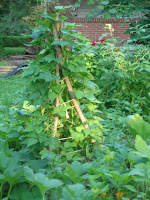 Lawn to Edible Garden
Lawn to Edible GardenWhen we got pretty well settled into our new home, we decided we wanted to mow less grass and create a yard that was filled with edible food. It makes more sense to us to have a yard that produces food than to have grass that uses resources to be watered and mowed, but that doesn't serve a useful purpose. We used some of the principles of Permaculture and then jumped in to try our hand at growing some of our own food.
 The word Permaculture comes from both "permanent culture" and "permanent agriculture" and is "a set of techniques and principles for designing sustainable human settlements" (Toby Hemenway, Gaia's Garden). We are total novices at practicing permaculture, but what we want to do is develop a yard that is not only beneficial to us, but to the plants, animals, insects - and other humans that we live with. For us that means not using pesticides and sprays, creating interconnections between the plants, animal, and insects in our living space, and using recycled and natural materials to develop the garden. It seems logical to us to create an edible landscape that is both beautiful and useful.
The word Permaculture comes from both "permanent culture" and "permanent agriculture" and is "a set of techniques and principles for designing sustainable human settlements" (Toby Hemenway, Gaia's Garden). We are total novices at practicing permaculture, but what we want to do is develop a yard that is not only beneficial to us, but to the plants, animals, insects - and other humans that we live with. For us that means not using pesticides and sprays, creating interconnections between the plants, animal, and insects in our living space, and using recycled and natural materials to develop the garden. It seems logical to us to create an edible landscape that is both beautiful and useful.We started by planting fruit and nut trees, as well as berry bushes and perennial vegetables that would become a permanent part of the structure of our garden. We planted apple, paw paw, and chestnut trees, as well as blueberries, raspberries, strawberries, blackberries, serviceberries, asparagus, Jerusalem artichokes, rhubarb, and some perennial flowers and herbs. This gave us the beginnings of a structure for what some people call an edible forest garden. The picture below left is an apple tree (protected by deer fencing) with beans and summer squash growing next to it. We expanded a flower bed that was already developed as a foundational structure to plant the apple trees around as well as to plant vegetables in.



Once we had the trees and bushes planted we went about developing beds to plant our annual vegetables and herbs. We planted butternut, acorn, and summer squash, zucchini, potatoes, parsnips, carrots, beets, tomatoes, cucumbers, sweet potatoes, beans, peas, basil, lettuce, garlic, and a variety of edible flowers. The edible flowers above were a delicious and beautiful way to add color to the bed in front of our house. We planted nasturtiums, Maximillian sunflowers, calendula, safflowers, hyacinth runner beans, scarlet runner beans, hollyhocks, bee balm, marigolds, violets, Sweet William, and flax.
We learned a lot during the last growing season and we had a lot of great food to eat straight out of our garden. It was wonderful to go gather a salad or to create a meal with fresh zucchini or summer squash. I loved picking basil and making fresh pesto, or simply putting a lot of basil in my salads. Sometimes I just foraged through the garden munching on sugar snap peas and cherry tomatoes. It was satisfying to know that the work we put into our yard had a purpose, and that we could eat the fruits of our labor.
That was all great, but we have a LOT more to learn. We had to water quite a bit and our water bill was enormous! We need to learn more about collecting water with rain barrels and about mulching to hold the moisture from the morning dew in the ground. We planted some things that we aren't familiar with and that didn't grow very well like lovage, fava beans, and salvia (I don't even know what that is!) , so we will probably stick with more conventional vegetables that grow well in Ohio until we get better at what we are doing. There was a tomato blight, so our tomatoes were orange and the plants got really brown, and our corn was full of worms. I thought I could leave the sweet potatoes in the ground and harvest them this winter, so I was really disappointed when I harvested them a few days ago for our Winter Solstice meal and they were brown and weird. I was happy, however, to find that the parsnips had grown throughout the fall and were very tasty! I know that Jerusalem Artichokes are a staple of permaculture gardens because they are a prolific perennial plant, but we haven't really warmed up to eating them. I have a bag of them in the refrigerator that I harvested on the Winter Solstice, but I haven't been terribly motivated to cook them along side all of our tasty holiday food. We had a beautiful garden, but we also have a huge learning curve. We want to give ourselves a lot of time to learn so that, in the event that it becomes necessary for more of us to grown our own food, we have some wiggle room to make a lot of mistakes.

We will post more information about how we set up our garden beds, getting the raw materials like manure, wood chips, and old carpet (yes, that's right - carpet!), but I am still struggling to figure out how to upload photos on this blog and put them where I want them with the text, so...another learning curve!




No comments:
Post a Comment